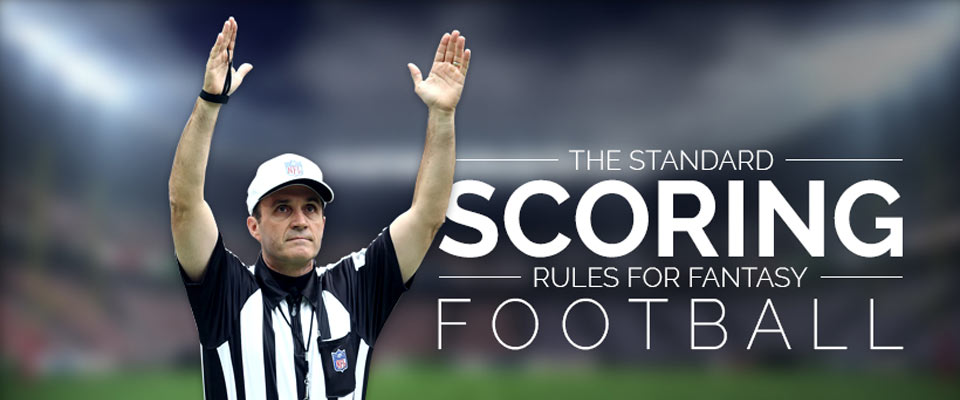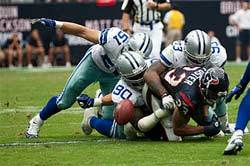
One of the major decisions all commissioners must contemplate when configuring their fantasy leagues is which fantasy football scoring systems to implement. This is an important decision as the chosen scoring system will dictate how owners create their cheat sheets, make their draft picks on the league fantasy draft board, and subsequently how their players accumulate points throughout the season.
But which of these systems is the best scoring configuration for your fantasy football league? That’s what I reveal in this fantasy football scoring guide.
Basic Fantasy Football Scoring Rules
Regardless of the scoring system you choose for your league, the fantasy football points system used to reward statistical output remains [largely] the same.
Offensive Scoring Rules
- Passing Yards: 1 point per 25 yards
- Passing Touchdowns: 6 points
- Passing Yards: 1 point per 10 yards
- Interceptions: -2 points
- Fumble Lost: -2 point
- Rushing Yards: 1 point per 10 yards
- Rushing Touchdowns: 6 points
- Receptions: 1 point (PPR scoring system only)
- Receiving Yards: 1 point per 10 yards
- Rushing Touchdowns: 6 points
Kicker Scoring Rules
- Extra Points: 1 point
- Missed Extra Point: -2 points
- Field Goal 17-39 Points: 3 points
- Field Goal 40-49 Points: 4 points
- Field Goals 50-59 Points: 5 points
- Field Goals 60+ Points: 6 points
- Missed Field Goal: -2 points
Defense & Special Teams Scoring Rules
- Blocked Kick: 2 points
- Safety: 2 points
- Forced Fumble: 1 point
- Fumble Recovery: 1 point
- Interception: 2 points
- Sack: 1 point
- 0 Points Allowed: 10 points
- 1-6 Points Allowed: 8 points
- 7-13 Points Allowed: 6 points
- 14-20 Points Allowed: 2 points
- 21-27 Points Allowed: 1 point
- 28-34 Points Allowed: 0 points
- 35-41 Points Allowed: -2 points
- 42+ Points Allowed: -4 points
The 3 Most Popular Scoring Systems
There are three primary fantasy football scoring types (systems) in use today. Most standard leagues implement some variant of these point systems:
- Standard Scoring System
- Points Per Reception System (PPR)
- Individual Defensive Player (IDP)
The Standard Scoring System is the best system for new fantasy leagues or existing fantasy leagues that want to keep things simple. This contrasts to playoff fantasy football leagues, where formats are quite varied.
Its settings are tried, true, and proven to keep league scoring well-balanced.
The Points Per Reception System enhances standard scoring by introducing another statistical category to increase overall scoring. Awarding players with a point per reception means overall scoring across all teams will rise by at least 7000 points.
Finally, Individual Defensive Player complements Standard Scoring or PPR and is best suited for hard-core owners who invest considerable time in their leagues.
If you’re looking for unorthodox scoring rules, check out some paid fantasy football leagues. From Terminator and Super Bracket leagues to best ball leagues, these cash leagues add some interesting twists to the standard point systems we know so well.
The Standard Fantasy Football Scoring System
The standard fantasy football scoring system is a well-respected baseline of scoring rules. The points system which forms this framework is designed to promote balance across the various fantasy positions.
The standard scoring system is the typical model chosen by first-time fantasy football commissioners because it is a basic points system that is intuitive for beginners.
The points system defined in the standard scoring system was formulated to ensure that each fantasy position has roughly the same relative value as the other fantasy positions for similar on-field production.
Thus, it aims to calibrate the weight of each fantasy statistic so that each fantasy position has comparable value to your team.
Next, we’ll outline the basic point guidelines of standard fantasy football scoring for each offensive and defensive fantasy position.
Offensive scoring rules in standard scoring
The standard fantasy football scoring system defines rules for offensive scoring and DST (Defense and Special Teams) scoring. A typical fantasy lineup usually comprises 8-12 offensive positions and 1 DST position. Let’s talk about the typical point values applied to offensive production.
Standard points values for offensive stats
Offensive fantasy football scoring rules are well-established, especially when compared to their Defense/ST counterparts. Every fantasy league using standard scoring utilizes the following point values (or something very similar).
A touchdown is worth 6 points
In the standard fantasy football scoring system, touchdowns are universally worth 6 points, just like in the NFL. It does not matter if the touchdown was scored by a quarterback, receiver, running back, or even a kicker. All touchdowns are worth 6 points.
Some scoring rules dictate that touchdowns are only worth 4 points. These are not the standard scoring system.
Score 1 point for every 10 rushing yards
Each rushing yard is worth .1 point (if your league awards fractional points, which it should), or 1 point for every 10 yards. Leagues that don’t award fractional points should be extinct by now.
Score 1 point for every 10 receiving yards
Similar to rushing yards, each receiving yard in fantasy football is worth .1 point, or 1 point for every 10 yards.
Score 1 points for every 25 passing yards
Because passing yards are much easier to come by than rushing or receiving yards, they are not worth quite as much. Passing yards in the standard scoring system are worth .04 point per yard, or 1 point for every 25 yards.
How Standard Scoring Achieves League Balance
The four statistic/point-value pairs just covered (touchdowns, rushing yards, receiving yards, and passing yards) form the basis of the standard fantasy football scoring system. To get an idea of how this point system aims to promote balance, imagine that during a football game, the following statistics are compiled for the five typical offensive fantasy positions:
- Quarterback: 250 yards passing, 1 touchdown
- Running Back: 40 yards rushing, 2 touchdowns
- Wide Receiver: 100 yards receiving, 1 touchdown
- Tight End: 100 yards receiving, 1 touchdown
- Kicker: 2 40-yard FGs, 1 50 yard FG, 3 extra points
If you were to ask several different people which of these players had the best game, you’d probably hear several different answers. This is because each player had roughly the same level of production relative to the position that they play.
As such, if these stats were to be applied to the standard scoring system, each of these players would have compiled the same fantasy point total: 16 points. This is the level of balance that standard scoring aims to achieve.
Other common offensive stat values
While the aforementioned statistic/point-value pairs form the basis of the standard scoring system, the following statistics should also be a part of any fantasy football point configuration. However, these associated point values may vary slightly from league to league.
Throwing an interception is worth -2 points

The average NFL quarterback’s ratio of TDs to INTs is generally about 3-1. For instance, in 2017 Phillip Rivers, Russell Wilson, and Case Keenum all had TD-INT ratios of about 3-1.
This 3-1 ratio forms the basis for an interception’s negative point value in fantasy football. In other words, it will take 3 interceptions to negate a 1 touchdown, so each interception will subtract 2 points from your starting fantasy quarterback’s (and thus your fantasy team’s) point total.
Losing an offensive fumble will cost you 2 points

The negative point value attributed to a lost fumble is most commonly -2 points, although this can take different forms. For example, some fantasy football platforms allow you to assign distinct point values to both fumbles that are lost AND fumbles that are recovered by the offense.
For fantasy leagues that offer this level of detail, it is not uncommon to see commissioners associate -1 point with a fumble that is recovered by the offense and -2 points with a fumble that is turned over to the defense.
Field goals are worth 3 points or more for longer kicks

In the early days of fantasy football, all field goals were worth 3 points. After scoring configurations became more granular , field goals still typically started at 3 points but increased in value as the distance (and thus the difficulty) of the field goal increased.
There are no standard guidelines governing how a field goal’s point value should be increased with distance, but a common approach is to award an additional point (4 points total) for any kick between 40 and 50 yards, another point (5 points total) for a kick between 51 yards and 59 yards, and finally 6 points for any field goal 60 yards are longer.
Applying fractional points to field goals
If your league hosting service allows it, a further refinement of field goal point configuration is to award fractional points based on field goal distance. Configuring points in this manner would be similar to how partial points are awarded for yardage to the quarterback, running back, and wide receiver positions.
Some fantasy hosts support this option while others don’t. If your league supports it, I highly advise you implement this fractional field goal scoring as it is a much more balanced way to award points to kickers.
Using the fractional approach, you could award 3 fantasy points for every field goal up to 39 yards, 4 fantasy points for a field goal of 40 yards, then award an additional .1 fantasy point per yard for field goals 40 yards or greater. For instance, a 41 yard field goal would be worth 4.1 points, a 42 yard field goal would be worth 4.2 points, and so on.
The fractional approach to scoring field goals adds an element of granularity and fairness that could be the difference in the outcome of a game or two during your fantasy season.
Defensive/Special Teams Scoring

The following statistics are factored into the scoring rules for the Defense/Special Teams(DST) fantasy football position. Under the standard scoring configuration, the special teams and defense of each team are combined to form one fantasy position, DST.
Of all the fantasy football positions, the statistic/point-value assigned to the Defense/ST position are the most varied. The best fantasy football leagues put their own personal touch on these settings so any small deviation from the following point values is acceptable
A blocked kick is generally worth 2 points
Blocking any type of kick, whether it be an extra point, field goal, or even a punt is generally worth two points.
Safeties can be anywhere from 2 to 6 points
The most common value for a safety is 2 points. However, I have been in some leagues where we awarded 6 points for a safety since they’re most common than a touchdown.
If your defense or special teams forces a fumble, it’s worth 1 point
Fantasy leagues vary, but forcing a fumble is generally worth 1 point. Some leagues only award points (2) for a forced fumble that is actually recovered by the defense, but zero points if they force a fumble and the offense recovers.
However, I personally like to split these points across two categories: forced fumbles and fumble recoveries. Some league hosts provide this option while others do not.
A fumble recovery is worth 1 point
A fumble recovery is worth 1 point or, as previously mentioned, may be worth 2 points if no points are awarded for the forced fumble itself.
If you use overall team points as the basis for determining your league’s worst team, consider also instituting a funny fantasy football punishment to encourage league participation. An embarrassing deterrent can go a long way toward ensuring all of your league owners actively manage their teams.
Interceptions by your defense are 2 points
Interceptions are almost universally worth 2 fantasy points. These points counter the -2 fantasy points which are taken from the fantasy quarterback who threw the interception.
Defensive sacks will earn your team 1 point
I have never seen a point configuration where sacks are worth anything other than one fantasy point.
Scoring fantasy points based on the points your DST allowsed
Unlike in the early years of fantasy football, a good DST position can earn you some heft point totals. It isn’t uncommon to see a DST score 20-40 points in a game, especially if the defense records shutout or a scores a touchdown or two.
Part of a DST’s total score comes from the total points they allow the opposing team to score. The fewer points a DST allows, the higher point total they are awarded. Variations of this setting are common, but here are the groupings that I see most often and that I use in my leagues:
- 0 Points Allowed (Shutout): 10 Points
- 1 – 6 Points Allowed: 8 Points
- 7 – 13 Points Allowed: 6 Points
- 14 – 20 Points Allowed: 2 Points
- 21 – 27 Points Allowed: 1 Point
- 28 – 34 Points Allowed: 0 Points
- 35 – 41 Points Allowed: -2 Points
- 42+ Points Allowed: -4 Points
Remember, Points Allowed is just one category on which your DST is scored. They also accumulate points for sacks, interceptions, touchdowns, etc.
When standard scoring might be good fit for your league
The standard fantasy football scoring system works especially well in the following scenarios.
- New leagues that want to use a simple and proven scoring configuration
- Leagues comprised of passive fantasy owner who don’t want to invest a lot of time into their research
- Any league that wants to keep things simple and straight-forward
The standard scoring system hasn’t changed much throughout the years and is a solid, balanced point configuration. You simply can’t go wrong when utilizing this points system for your league.
Points Per Reception (PPR) Scoring System

As fantasy football increased in popularity over the years, some fantasy veterans began to get bored with the standard scoring system. It wasn’t that the standard system was flawed, it was simply that owners wanted their leagues to incorporate more scoring and draft strategy.
If more points on the scoreboard makes the NFL more exciting, shouldn’t the same should hold true for fantasy football?
It was out of this desire for more scoring that the Points Per Reception system was born. The PPR system is identical to standard scoring with one important exception: players receive additional points for every reception (usually 1 point but sometimes 1/2 point, varying by league).
While this scoring adjustment may seem minor, it actually has a considerable effect on player scoring. As a result, it’s becomes a key factor in how you configure your custom fantasy cheat sheets. For instance, a player’s fantasy ranking under the PPR scoring system could differ by as much as 10 positions when compared to their output using standard scoring.
When your league should consider the PPR scoring
Most leagues start out using the standard scoring configuration, but there is no reason not to start out as a PPR league if most of your owners are in favor of this system. It may require that your owners pay a little more attention to stats when preparing for their drafts, but many people swear by this system.
Another reason you may want to consider PPR for your league is if people are losing interest and you’re looking for a way to spice things up. The increased scoring in PPR could help to get your owners re-engaged.
Individual Defensive Player (IDP) Scoring System
In the years since the PPR scoring system became commonplace, fantasy owners have continued to push the envelope. With the advent Individual Defensive Player leagues, a whole new dimension of scoring and strategy was created as fantasy positions were extended to the defensive side of the ball.
IDP isn’t a replacement system for standard scoring or PPR systems, rather it is a scoring system that you would implement alongside with your existing scoring configuration.
The positions considered in IDP scoring
Much like the standard offensive positions, defensive positions accumulate points when they amass positive statistics including sacks, tackles, forced fumbles, and interceptions. Here are the seven defensive fantasy positions, by position grouping
IDP Scoring Rules
- Tackles (Solo): 1 point
- Tackle Assists: .5 point
- Sacks: 2 points
- Sack Yardage: 1 point per 10 yards
- Tackles for a Loss: 1 point
- Quarterback hits: 1 point
- Passes Defended: 1 point
- Interceptions: 3 points
- Fumbles Forced: 3 points
- Fumbles Recovered: 3 points
- Defensive Touchdowns: 6 points
- 2-Point Conversion Returns: 2 points
IDP Positions
- Defensive Linemen
- Defensive Tackle
- Defensive End
- Linebackers
- Middle Linebacker
- Outside Linebacker
- Defensive Backs
- Cornerback
- Nickleback
- Safety
Leagues that would benefit from IDP Scoring
IDP is definitely not for every fantasy league because of complex scoring rules and additional player management. However, the following types of leagues may be a good fit for IDP:
- Leagues which have used various systems in the past and want to encourage more fantasy draft strategies to their leagues
- Leagues with engaged owners who are willing to invest the time and effort necessary to evaluate defensive talent and manage additional players
If the extra work required to manage defensive players would alienate some of your league members, it’s probably best to stick to a standard or PPR-based league (or maybe create a new fantasy league strictly for owners interested in IDP).
Choosing the Best Scoring System for your League
Scoring systems are generally chosen based on the experience-level and personality of the league owners. When considering which system to implement, ponder the following questions:
- Is this your league’s first year?
- Is your league comprised mostly of novices or fantasy veterans?
- How much of time do you expect your owners to commit to the league?
- Are your owners the types who would enjoy complex scoring systems with high-scoring games, or would they prefer a simple and straight-forward system?
The answers to these questions will help you choose the best scoring system for your league. Let’s dive into the details and discover how to match a scoring system to your league’s personality.
Which scoring systems have worked the best for your fantasy leagues?
